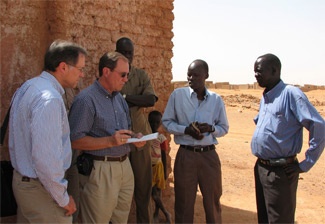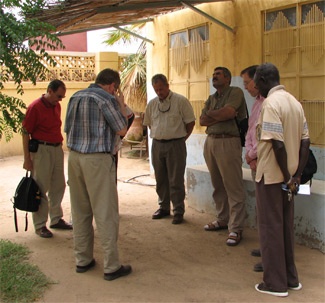|
|
The dynamics of globalization are driving ministries and missions toward greater international integration as surely as it has impacted international business. Advances in technology have enabled the crossing of international borders with increasing regularity and relative ease. Countless organizations and institutions are expanding their transnational activities through partnerships and alliances, and are thus experiencing the effects of a dramatically diverse array of cultures and worldviews. How can leaders of international ministries and missions help their organizations not just to cope with the challenges, but to proactively seize new opportunities resulting from globalization?
Powerful Forces Impel Organizations Toward Greater International Integration
Globalization represents the long-term process by which the world and its myriad of peoples are becoming increasingly interconnected and interdependent in nearly every dimension of society. It involves interactive social process on a worldwide scale in which people interrelate, communicate and work in an increasingly culturally-diverse setting. The phenomenon became widely recognized in the 1980s and has become a reality for organizations in every developed and developing nation.1 Organizations of every kind are operating today in an environment that continues to become increasingly global and culturally diverse.
Globalization presents major challenges and significant changes, yet new opportunities also emerge. For churches, mission agencies and other ministry organizations that want to make a positive impact beyond national borders, and hope to thrive within an environment of increasing international integration, a firm grasp of the challenges and changes proves crucial to recognizing and seizing these strategic opportunities.
New Dynamics Continue to Compel Changes to Old Mental Frameworks
The new global reality that organizations and their leaders face is a rapidly changing international context. The intercultural dynamics of increasing globalization demand strategic cultural thinking and a global mindset that sees beyond national borders and is open to exchanging new ideas. Leaders of all organizations find themselves increasingly working in a fluid environment requiring flexible thinking to adapt quickly to new and different intercultural environments. Globalization itself need not be feared or resisted. While the powerful dynamics driving globalization can produce unpredictable effects, the forces themselves are morally neutral and must be purposefully navigated. Globalization trends enhance an interconnectedness that carries the potential for expanding international ministry through healthy integration and biblical interdependence.
The leadership challenge that globalization presents in missions today arises in understanding these fluid and unpredictable dynamics and then harnessing international integration to achieve biblically righteous objectives by building relationships grounded in mutual respect and trust, engaging in healthy interdependence cross-culturally and extending global community centered on God’s kingdom culture. In missions ministry, globalization not only continues to break down paternalistic approaches to “partnering” in missions, but it accomplishes much more by moving us beyond mental models and strategies of simple indigenization.
![]() To the same extent that world events brought down the remaining vestiges of national and economic forms of colonialism by the 1970s, so too by the close of the 1990s the dynamics of globalization had proven the deficiency of missions strategies based simply on lifting up indigenous workers and launching their isolated ministries. Rather, a more compelling motive for engaging the dynamics of globalization as these affect ministry is to seize the strategic new opportunities for achieving the creative synergies that are possible only through broader and more effective international integration.2
To the same extent that world events brought down the remaining vestiges of national and economic forms of colonialism by the 1970s, so too by the close of the 1990s the dynamics of globalization had proven the deficiency of missions strategies based simply on lifting up indigenous workers and launching their isolated ministries. Rather, a more compelling motive for engaging the dynamics of globalization as these affect ministry is to seize the strategic new opportunities for achieving the creative synergies that are possible only through broader and more effective international integration.2
Global Alliances Afford Greater Synergies and Effectiveness
In an increasingly globalized environment, organizations in different nations can expand their reach and effectiveness by building global partnerships, transnational partnerships and international strategic alliances with other organizations. The term “global alliances” encompasses all of these.3 Such arrangements are especially useful where organizations are operating in highly fluid environments of increasing informational complexity and cultural diversity. Relationships built on mutual respect and trust hold significant potential benefits, including increased confidence and security, reduced transactional costs and better information exchange and creative synergies generated by cultural diversity.
|
|
Keys for Initiating and Engaging in Effective Global Alliances for International Ministry
Many of the same dynamics of globalization that motivate commercial organizations to seek transnational partnerships and strategic international alliances also fundamentally serve as inducements for ministry organizations to engage like-minded ministry organizations in global alliances. The willingness to trust and to act jointly with another organization in pursuit of mutually compatible interests of the partners in the alliance, rather than to act opportunistically, constitutes the glue of strategic inter-organizational collaboration that essentially bonds their relationship. And yet, the motivation for international integration among Christian ministry organizations draws its life and energy from an even deeper source. The following are four indispensable elements for ministry and missions leaders to consider in the course of initiating and engaging in global alliances.
1. Build global alliances based on a strategy consistent with biblical unity. Global alliances constitute a biblically sound vehicle for expanding ministry effectiveness through international collaboration. Spiritually healthy alliances among Christian ministries depend on the Spirit-led unity among believers that Jesus Christ asked the Father to preserve. Jesus prayed for his followers “that all of them may be one” in “complete unity” for a global purpose: “to let the world know that you sent me” and “so that the world may believe that you have sent me” (John 17:21-23). Likewise, the Apostle Paul wrote and acted from a global mindset that saw beyond all distinctions among social and economic classes, people groups and national borders (see Galatians 3:26-29 and Ephesians 2:19).
![]() As an example of increasing international integration in ministry, consider the experiences of the international ministry organization in which I serve. This comparatively young missions movement has grown steadily and globally beyond its United States origins. Over the years, believing that the Great Commission belongs to the Church worldwide, the mission has forged partnerships with numerous non-Western nationals who have developed their own indigenous ministries.
As an example of increasing international integration in ministry, consider the experiences of the international ministry organization in which I serve. This comparatively young missions movement has grown steadily and globally beyond its United States origins. Over the years, believing that the Great Commission belongs to the Church worldwide, the mission has forged partnerships with numerous non-Western nationals who have developed their own indigenous ministries.
Many of these individual nationals and their indigenous ministries continue today as the agency’s “global partners.” And through a gradual adaptation process of “internationalization,” many of these non-Western nationals now hold positions as member missionaries within the agency’s international structure and have assumed key positions as field leaders and/or mobilization base directors. This reflects good progress toward helping to indigenize ministry and to empower national leadership. Yet, adapting to the larger dynamics of international integration will require discernment at a deeper level regarding how to fully integrate with the structures and systems of other international organizations and ministry movements.
2. Choose relationships for global alliances based on shared values and genuine respect. The next step in building a healthy global alliance involves choosing prospective partners who have a mutually agreed upon vision for ministry, shared core values and compatible ministry objectives. By its nature, a global alliance integrates the operations of two or more organizations to produce synergies and efficiencies while still allowing each entity to preserve its distinct identity, if the partners choose to do so. It is neither a merger nor a takeover. Each partner must sincerely respect what the other partner(s) bring to the relationship. Indeed, much of the strength of a global alliance derives from an appreciation of the unique and separate contributions of the partners.
3. Understand the importance of mutual trust in building partnerships and alliances. One of the most critical and complex aspects on which a global alliance’s effectiveness depends is the relationship of trust that underlies the alliance. Authentically interdependent relationships are grounded in mutual trust. People naturally tend to trust those who share the perspectives we have and who see the world the way we do. The cross-cultural challenge lies in finding a way for the prospective partners to extend their natural radius of trust to engage each other in relationship. Developing a trusting relationship requires each party to demonstrate (a) honesty and integrity, (b) caring concern for the welfare of others and (c) an ability or capacity to do what has been promised.
![]() For prospective partners who are coming from a genuinely Christ-like perspective, shared biblical values and moral integrity is an enormous advantage that greatly expedites the process of achieving initial trust. In the attempt to achieve clarity in advance about mutual expectations and to ensure performance by another, some ministry organizations have emphasized written agreements that often reflect a Western bent toward a contract-based, litigation-driven strategy of constructing substitutes for trust.
For prospective partners who are coming from a genuinely Christ-like perspective, shared biblical values and moral integrity is an enormous advantage that greatly expedites the process of achieving initial trust. In the attempt to achieve clarity in advance about mutual expectations and to ensure performance by another, some ministry organizations have emphasized written agreements that often reflect a Western bent toward a contract-based, litigation-driven strategy of constructing substitutes for trust.
|
|
4. Be proactive in taking risk in relationship. To actually build a trusting relationship in a global alliance each partner must demonstrate the willingness to trust. This requires risk-taking in the relationship. Action that demonstrates willingness to trust involves accepting vulnerability to one another, and taking steps toward interdependence among partners. An inherent dilemma in forming new global alliances, however, is that trust often must begin with crucial gaps of information and without any accumulation of reliable experiences with the other party. Actions demonstrating willingness to trust become especially critical where prior knowledge about each other is low and in cross-cultural relationships where the risks may appear high. Initiating global alliances often requires courage and initiative to proactively engage risk in relationship and to manifest an initial trust on which to build the newly emerging partnership or alliance.
Conclusion
While globalization is a reality that already has brought major changes, the full extent of its implications for organizations and leaders is still unfolding. Globally-minded leaders will recognize the potential advantages of increasing international integration and will demonstrate a willingness to engage the opportunities afforded by it. Effective leadership therefore continues to play a decisive role in the success or failure of global alliances that can proactively meet the challenges of globalization.
Endnotes
1) Thomas Friedman contends that the year 2000 saw additional forces combining in a way that launched the world into a third era or level of globalization, the dynamics of which are driven far less by Western, developed nations and much more by non-Western, “non-white” nations. (Friedman, Thomas. 2006. The World is Flat: A Brief History of the Twenty-first Century. Rev. ed. New York: Farrar, Straus and Giroux.)
2) To understand globalization as a dynamic that increases international integration is in no way inconsistent with a Samuel Huntington view of the world as moving toward increasing factionalism in a “clash of civilizations.” Huntington’s proposition is controversial, but to the extent it is accurate one can readily see a relation between the two phenomena. Greater global integration simply reflects that increasing ideological fragmentation has international effects that are more direct and immediate and also broader in scope.
3) Both the words “partnership” and “alliance” refer to two or more autonomous organizations associating either formally or informally, with or without a written or legally binding agreement. For some persons who attempt to articulate a distinction, a partnership connotes a dyadic relationship (i.e., between two entities), whereas an alliance implies a collective association (i.e., a group of three or more entities).




